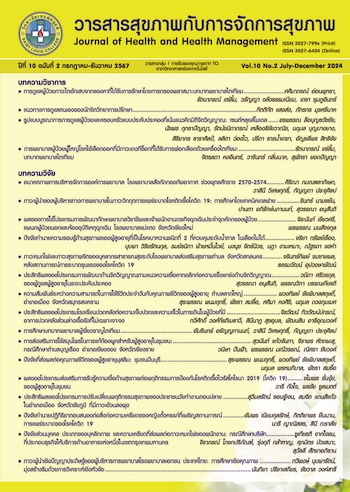Self-Care Strategies for Counseling Psychologist
Keywords:
Self-care, Counseling, CounselorAbstract
Self-care refers to the practices individuals engage in to maintain or enhance their own health, happiness, and well-being, especially during times of pressure. It is a crucial component in preventing, managing, or mitigating stress and its associated adverse effects that may arise in demanding work environments. For counseling psychologists, self-care is essential, as it enables them to maintain energy and happiness effectively. It is vital for counseling psychologists to uphold and promote optimal well-being in their physical, emotional, and spiritual aspects, ensuring they meet their professional responsibilities without impairment. Without proper self-care, counseling psychologists may experience stress, compassion fatigue, and burnout, which hinder their ability to provide effective services. Self-care for counseling psychologists is divided into six domains: 1. Physical self-care 2. Professional self-care 3. Relational Self-Care 4. Emotional Self-Care 5. Psychological self-care 6. Spiritual self-care. These six areas of self-care guide counseling psychologists in adopting self-care practices that prevent workrelated impairments and negative impacts on their physical health, mental health, life satisfaction, work performance, and social interactions.
References
สมาคมจิตวิทยาการปรึกษาแห่งประเทศไทย. (2567). จรรยาบรรณวิชาชีพนักจิตวิทยาการปรึกษา. สืบค้นจาก https://www.thaicounseling.org/thai-counseling-psychologist-professional-ethics
American Counseling Association. (2014). ACA code of ethics. Retrieved from https://www.counseling.org/docs/default-source/default-document-library/ethics/2014-aca-code-of-ethics.pdf
Bakker, A. B., & Demerouti, E. (2008). Towards a model of work engagement. Career development international, 13(3), 209- 223.
Barnett, J. E., & Cooper, N. (2009). Creating a culture of self-care. Clinical Psychology: Science and Practice, 16(1), 16-20.
Butler, L. D., Mercer, K. A., McClain-Meeder, K., Horne, D. M., & Dudley, M. (2019). Six domains of self-care: Attending to the whole person. Journal of Human Behavior in the Social Environment, 29(1), 107-124.
Craft, L. L., & Perna, F. M. (2004). The benefits of exercise for the clinically depressed. Primary care companion to the Journal of clinical psychiatry, 6(3), 104-111.
Daniels, M. (1982). The development of the concept of self-actualization in the writings of Abraham Maslow. Current Psychological Reviews, 2(1), 61-75.
Dye, L., Burke, M. G., & Wolf, C. (2020). Teaching mindfulness for the self-care and well-being of counselors-in-training. Journal of Creativity in Mental Health, 15(2), 140-153.
Figley, C. R. (1995). Compassion fatigue: Coping with secondary traumatic stress disorder in those who treat the traumatized. USA: United States of America on acid-free paper.
Gentry, J. E., & Baranowsky, A. B. (2013). Trauma practice: Tools for stabilization and recovery. Retrieved from https://www.academia.edu/69701581/Trauma_practice_Tools_for_stabilization_and_recovery
Gómez-Pinilla, F. (2008). Brain foods: the effects of nutrients on brain function. Nature reviews neuroscience, 9(7), 568-578.
Hirshkowitz, M., Whiton, K., Albert, S. M., Alessi, C., Bruni, O., DonCarlos, L., ... & Hillard, P. J. A. (2015). National Sleep Foundation’s sleep time duration recommendations: methodology and results summary. Sleep health, 1(1), 40-43.
Holt-Lunstad, J., Smith, T. B., & Layton, J. B. (2010). Social relationships and mortality risk: a meta-analytic review. PLoS medicine, 7(7), e1000316. doi: 10.1371/journal.pmed.1000316
Kabat-Zinn, J. (2013). Full catastrophe living: Using the wisdom of your body and mind to face stress, pain, and illness. Retrieved from https://ird.mcu.ac.th/wp-content/uploads/2021/07/Full-Catastrophe-Living-PDFDrive-.pdf
Kaplan, S. (2012). The restorative benefits of nature: Toward an integrative framework. Journal of Environmental Psychology, 15(3), 169-182.
Krause, N., & Hayward, R. D. (2012). Religion, meaning in life, and change in physical functioning during late adulthood. Journal of Adult Development, 19(3), 158-169. doi: 10.1007/s10804-012-9143-5
Lee, J. J., & Miller, S. E. (2013). A self-care framework for social workers: Building a strong foundation for practice. Families in Society, 94(2), 96-103.
Maslach, C., & Leiter, M. P. (2016). Understanding the Burnout Experience: Recent Research and Its Implications for Psychiatry. World Psychiatry, 15, 103-111. doi: 10.1002/wps.20311
Maslow, A. H. (1943). A theory of human motivation. Psychological Review, 50(4), 370-396.
Maslach, C., & Leiter, M. P. (2016). Burnout. In Stress: Concepts, cognition, emotion, and behavior. Academic Press. doi: 10.1016/B978-0-12-800951-2.00044-3
Micha, R., Peñalvo, J. L., Cudhea, F., Imamura, F., Rehm, C. D., & Mozaffarian, D. (2017). Association between dietary factors and mortality from heart disease, stroke, and type 2 diabetes in the United States. Jama, 317(9), 912-924.
Pargament, K. I. (1997). The psychology of religion and coping: Theory, research, practice. Guilford Press. Retrieved from https://books.google.co.th/books/about/The_Psychology_of_Religion_and_Coping.html?id=Vn5XObcpnd4C&redir_esc=y
Pender, N. J., Murdaugh, C. L., & Parsons, M. A. (2011). Health promotion in nursing practice (7thed.). Retrieved from : https://sdh.gmu.ac.ir/Dorsapax/userfiles/file/HealthPromotioninNursingPracticebyNolaPender.pdf
Rupert, P. A., & Morgan, D. J. (2005). Work setting and burnout among professional psychologists. Professional Psychology: Research and Practice, 36(5), 544-550. doi: 10.1037/0735-7028.36.5.544
Seligman, M. E. P. (2011). Flourish: A visionary new understanding of happiness and well-being. Retrieved from https://books.google.co.th/books/about/Flourish.html?id=YVAQVa0dAE8C&redir_esc=y
Thoits, P. A. (2011). Mechanisms linking social ties and support to physical and mental health. Journal of health and social behavior, 52(2), 145-161.
Van Lith, T. (2016). Art therapy in mental health: A systematic review of approaches and practices. The Arts in Psychotherapy, 47, 9-22.
Walker, M. P. (2017). Why we sleep: The new science of sleep and dreams. Scribner.
Warburton, D. E., Nicol, C. W., & Bredin, S. S. (2006). Health benefits of physical activity: the evidence. Canadian Medical Association Jourrnal, 174(6), 801-809. doi: 10.1503/cmaj.051351
Downloads
Published
How to Cite
Issue
Section
License
Copyright (c) 2024 Journal of health and health management

This work is licensed under a Creative Commons Attribution-NonCommercial-NoDerivatives 4.0 International License.




